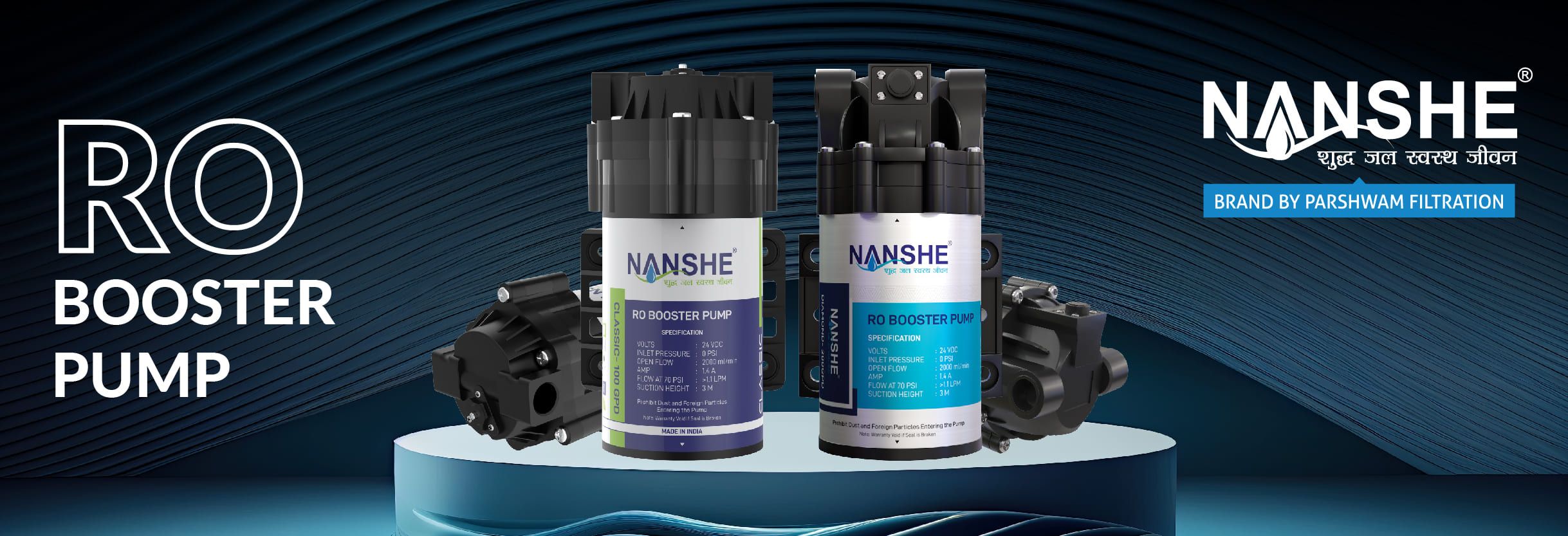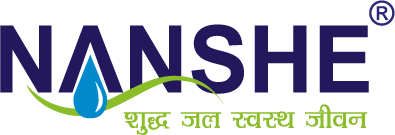
2024-03-08
RO Booster Pumps - What are they and how do they work?
Reverse Osmosis (RO) filtration systems are top-of-the-line water filters often found under sinks. They're super effective at removing lots of nasty stuff from water. But sometimes, they don't work as well as they should. One reason is low water pressure. When pressure's low, more water gets wasted, and fewer bad things get filtered out. That's where RO booster pumps, like the ones from Nanshe, come in. They keep the pressure right for the filter to work its best.
Osmotic pressure is also one of the factors. Osmotic pressure refers to the pressure that would have to be applied to water to prevent it from passing into an RO system by the osmosis process. The natural process that produces osmosis is called osmotic pressure. Osmotic pressure increases with the number of contaminants in the water. We have to overcome osmotic pressure to produce reverse osmosis. This will guarantee that there is sufficient pressure to deliver peak performance. In this blog, we will discuss all about what it is, how it works, what the types of RO booster pumps are, and all other related aspects. So, without further ado, let’s first understand what RO booster pumps are.
What are RO booster pumps?
High-pressure pumps, commonly referred to as RO booster pumps or Reverse Osmosis booster pumps, serve a crucial role in reverse osmosis setups by enhancing water pressure. They are essential when the water pressure from the source isn't sufficient for the RO system to function optimally.
In the reverse osmosis method, water is pushed through a specialized membrane at high pressure, effectively filtering out impurities and contaminants. This process guarantees the production of clean water. However, if the incoming water pressure is low, the RO system struggles to purify water effectively. This can result in lower water quality as contaminants might not be completely removed.
Nanshe's RO booster pumps address this issue by increasing the water pressure before it enters the reverse osmosis membrane. By raising the pressure levels, these pumps enable a more efficient purification process, ensuring thorough separation of contaminants from the water. Consequently, the reverse osmosis system performs significantly better.
How does the booster pump work?
A booster pump functions by increasing the water pressure in a system. In a reverse osmosis (RO) setup, the Nanshe booster pump is installed before the RO membrane. When water flows into the system, the booster pump raises its pressure, allowing it to pass more smoothly through the semi-permeable membrane of the RO system. This increased pressure improves the efficiency of the RO system, ensuring the removal of contaminants from the water, resulting in higher-quality purified water. Booster pumps typically use a motor to generate pressure and are controlled by a pressure switch or sensor to maintain the desired pressure level.
Do RO booster pumps increase water pressure and flow rate?
Yes, Nanshe's RO booster pumps make water go faster through a reverse osmosis (RO) system. It increases the water pressure, which helps push the water through a special membrane in the system. This makes the purification process work better and faster. With the booster pump, more water can move through the system in a shorter time, which means you get more clean water.
When the water pressure coming in is too low for the RO system to work well, the Nanshe booster pump helps in making the pressure right. This not only makes the RO system work better but also ensures that the purified water flows steadily and consistently. Overall, Nanshe's booster pumps are significant for making RO systems work and are best for giving us clean and safe drinking water.
Types of booster pumps
Permeate Pump:
This type of pump utilizes the hydraulic energy of the brine (wastewater) stream from the RO system to pump part of the feed water (incoming water) into the RO membrane. It operates without requiring electricity and is often considered energy-efficient.
Electric Booster Pump:
Electric booster pumps are powered by electricity and are typically installed on the feed water line before the RO system. They work by directly increasing the pressure of the incoming water to the desired level for effective filtration.
Hydraulic Booster Pump:
Hydraulic booster pumps are powered by the pressure of the feed water. They use the energy from the incoming water flow to boost pressure before it enters the RO membrane. These pumps do not require electricity to operate but may have limitations in terms of pressure increase compared to electric booster pumps.
Rotary Vane Pump:
Rotary vane pumps are a type of positive displacement pump that can be used as booster pumps in RO systems. They work by trapping water between rotating vanes and the pump housing to increase pressure. These pumps are often used in industrial RO applications.
Diaphragm Pump:
Diaphragm pumps operate by flexing a diaphragm to create a vacuum that draws in and pressurizes the water. They are commonly used in residential RO systems as booster pumps due to their compact size and efficient operation.
Centrifugal Pump:
While less common in RO systems compared to other types, centrifugal pumps can also be used as booster pumps. They operate by converting the rotational energy from a motor into kinetic energy to increase water pressure. They are more suitable for larger-scale RO systems or industrial applications.
Where is a booster pump essential?
Elevating Water Pressure:
In reverse osmosis (RO) systems, booster pumps serve to raise the pressure of the incoming water. This elevation is crucial because RO membranes necessitate a specific pressure level to effectively sift out contaminants from the water. By elevating the pressure, booster pumps enhance the efficiency and efficacy of the RO filtration process.
Addressing Insufficient Water Pressure:
In instances where the initial water pressure is inadequate for optimal RO system functioning, booster pumps step in to compensate. They achieve this by elevating the pressure to meet the required level. Low water pressure issues often arise in regions with high altitude or in structures with subpar plumbing setups.
Amplifying Flow Rate:
Beyond merely increasing pressure, booster pumps also amplify the flow rate of water through the RO membrane. This proves especially advantageous in setups with high water demand or where a swifter filtration pace is desirable.
Augmenting Filtration Efficiency:
A heightened pressure environment within the RO system fosters enhanced rejection of contaminants by the membrane, resulting in superior water quality. Booster pumps play a pivotal role in ensuring that the RO membrane operates within the optimal pressure range, thereby maximizing filtration efficiency.
Reducing Wastewater Generation:
Certain booster pump configurations, such as permeate pumps, aid in minimizing wastewater production in RO systems. Permeate pumps leverage the energy from the brine stream to elevate the pressure of the incoming water without additional electricity consumption. This leads to heightened efficiency and diminished wastewater output.
Ensuring Steady Performance:
Booster pumps contribute to maintaining consistent pressure and flow rates in the RO system, irrespective of fluctuations in the incoming water supply. This steadfastness guarantees reliable operation and a uniform output of high-quality water over time.
Types of booster pumps by Nanshe
Nanshe Booster pump classic: A compact yet powerful solution designed to elevate your water purification system. This pump is lightweight, tipping the scales at only 1.700 kg, yet it's built tough for lasting durability. It can pull water from different sources with ease, thanks to its 2-meter suction height, guaranteeing dependable performance. The Booster Pump Classic offers an open flow rate ranging from 1500 to 1800 ML/MIN, ensuring steady water pressure for top-notch filtration efficiency. With a capacity of 100 gallons per day (GPD), it's ideal for both residential and commercial settings where consistent water pressure is crucial.
Nanshe Self pressure regulation pump diamond: A cutting-edge solution designed to revolutionize your water purification experience. Weighing just 2.100 kg, this pump features copper winding for enhanced durability and performance. With an open flow rate ranging from 1500 to 1700 ML/MIN, it ensures consistent water pressure for optimal filtration efficiency. Available in capacities of 100, 150, and 300 GPD, the Nanshe Diamond Pump adapts seamlessly to various residential and commercial applications, offering unparalleled reliability and versatility.
Nanshe Booster pump ELITE: a high-performance solution engineered to elevate your water purification system. Weighing a mere 587 kg, this lightweight yet robust pump ensures ease of installation and durability. With a suction height of 2 meters, it effortlessly draws water from diverse sources, guaranteeing reliable performance. Boasting an open flow rate of 1500 to 1700 ml/min, the Nanshe Booster Pump Elite delivers consistent water pressure for optimal filtration efficiency. Ideal for residential and commercial applications, this pump with a capacity of 100 GPD is the epitome of reliability and performance in water purification.
Nanshe booster pump supreme: A pinnacle of performance and reliability in water purification. Weighing just 2.001 kg, this lightweight yet durable pump features copper winding, ensuring longevity and efficiency. With an impressive open flow rate ranging from 2000 to 2200 ML/MIN, it guarantees consistent water pressure for optimal filtration. Perfect for residential and commercial applications, the Nanshe Booster Pump Supreme with a capacity of 100 GPD is the epitome of excellence, delivering unparalleled performance to meet your water purification needs.
Conclusion:
In conclusion, reverse osmosis (RO) filtration systems are highly effective but can be hindered by low water pressure and osmotic pressure. Nanshe's RO booster pumps address these challenges by increasing water pressure before it enters the RO membrane, ensuring optimal system performance. These RO products amplify water pressure, enhancing filtration efficiency, improving flow rates, and maintaining consistent performance, ultimately providing clean and safe drinking water.
© Copyright 2022 by Nanshe

